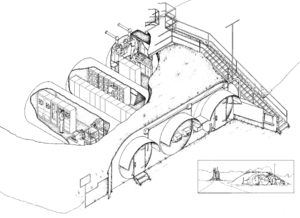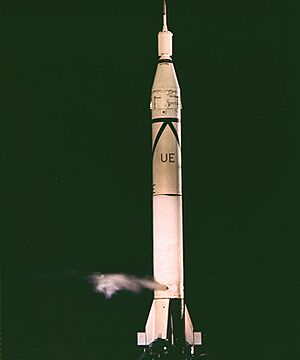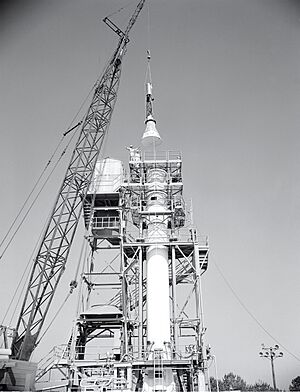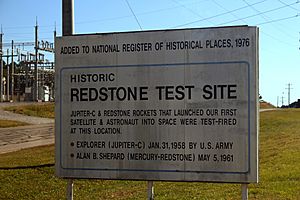Redstone Test Stand facts for kids
|
Redstone Test Stand
|
|
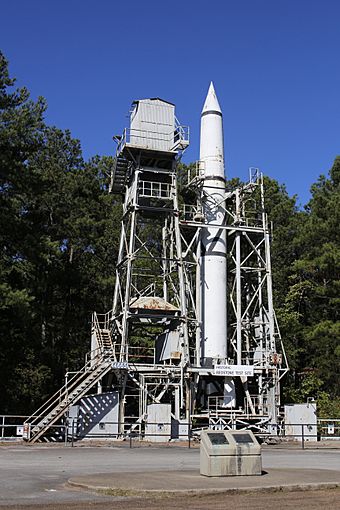
Redstone Test Stand at the MSFC in Huntsville, AL. Cold Calibration Unit (left) PGM-11 Redstone missile in static test stand (right)
|
|
| Nearest city | Huntsville, Alabama |
|---|---|
| Built | 1953 |
| Architect | U.S. Army |
| NRHP reference No. | 76000341 |
Quick facts for kids Significant dates |
|
| Added to NRHP | May 13, 1976 |
| Designated NHL | October 3, 1985 |
The Redstone Test Stand, also known as the Interim Test Stand, is a special place where important rockets were tested. It helped develop and test rockets like the Redstone missile, Jupiter-C sounding rocket, Juno I launch vehicle, and Mercury-Redstone launch vehicle.
This test stand is located at NASA's George C. Marshall Space Flight Center (MSFC) in Huntsville, Alabama. It's a very important historical site. In 1979, it was named an Alabama Historic Civil Engineering Landmark. Then, in 1985, it became a National Historic Landmark.
The Redstone missile was the first missile to carry a nuclear weapon. The Jupiter-C helped test parts for the Jupiter missile. The Juno I rocket put America's first satellite, Explorer 1, into orbit. And the Mercury-Redstone rocket carried the first American astronaut, Alan Shepard, into space! Because of the amazing work done here, the Redstone rocket earned the nickname "Old Reliable."
The Interim Test Stand was built in 1953 by Dr. Wernher von Braun's team. It was built very cheaply, costing only $25,000 in 1953. They used materials found around the Redstone Arsenal. Even when a bigger, permanent test facility was finished in 1957, the Army decided to keep using the Interim Test Stand. From 1953 to 1961, 362 rocket tests happened there. These tests helped make the Redstone rocket much better, especially for the Mercury space flights. This test stand shows how clever engineers were, as it never grew huge or super expensive like other test stands.
Contents
How Rockets Are Tested
Developing rockets that use liquid fuel usually happens in three main steps:
- Engine testing
- Static rocket testing
- Test launches
First, engineers test new rocket engines in a special facility. They choose the best designs and make them better through many tests. Once an engine works well, the whole rocket is put together.
In the second step, the rocket is tied down to a static test stand. This means it's held firmly in place. Engineers then turn on the engine at full power. This lets them check and improve the rocket's systems while it's still on the ground.
The third step is the test launch. This is when the rocket is finally fired into the sky. Dr. Wernher von Braun and his team used this same process to develop the V-2 missile in Germany during WWII.
After WWII, Dr. von Braun and his team came to the United States. They helped the U.S. Army learn about German missile technology. They also helped launch captured V-2 rockets and continued rocket research. This work happened at places like Fort Bliss, Texas and White Sands Proving Grounds.
In 1950, the Army brought all its rocket research together at Redstone Arsenal in Huntsville, Alabama. Dr. von Braun's team moved there. They started working on a new missile called Hermes C-1. Because of the Cold War and the Korean War, the missile needed to carry a heavy atomic bomb. This new, powerful missile was named Redstone. It had to be very reliable, accurate, and quick to build. The Redstone development program officially began on May 1, 1951.
Building the Test Stand
The first twelve Redstone missiles were built at Redstone Arsenal. In late 1952, work began on the first Redstone missile. Engineers urgently needed a test stand to improve the missile. However, they weren't allowed to use research money to build new facilities.
So, instead of waiting years for funding, an engineer named Fritz A. Vandersee designed a temporary test stand. It cost only $25,000, which was the most they were allowed to spend. Most of that money went into building a large concrete base. On top of this base, workers used salvaged metal from around the arsenal to build a small stand.
For control and observation, three old railroad tank cars were cleaned and buried about 300 feet away. These tanks acted as safe bunkers. To watch the rocket firings, the tanks even had two periscopes, possibly from old Army tanks.
In the spring of 1953, when the first Redstone missile was ready, the Redstone Interim Test Stand was also ready. A crane lifted the missile onto the stand. Cables were attached to hold it steady. After many checks, the missile was fueled. Its engine was then fired for short tests, usually no more than 15 seconds. After successful tests, the missile was sent to Cape Canaveral Air Force Station for its first flight.
While test launches gave important information about the guidance system, most improvements to the rocket's engine came from the Interim Test Stand. Here, engineers could study the engine's inner workings while it was held firmly on the ground. The first four missiles had a total of fourteen tests at this stand.
Engineers used the information from these static tests to constantly improve the Redstone missile. The next eight missiles went through twenty-two tests. A tall tower, called the Cold Calibration Unit, was built in 1954. It held the Redstone's fuel tanks and pumps. This unit helped test and calibrate the fuel system, making sure the right mix of alcohol and liquid oxygen was used. Getting the fuel mix wrong had caused many engine explosions in early rocket development.
Originally, the flames from the rocket engine were directed into a trench. In 1955, a new, stronger flame deflector was installed. This special elbow-shaped deflector used water to create steam, which kept the hot flames away from the metal.
Rocket Improvements and Space Race
On February 1, 1956, the Army Ballistic Missile Agency (ABMA) was formed. Their job was to make the Redstone rocket ready for use and to develop a new Jupiter missile. The Redstone missile continued to be tested, and the Interim Test Stand was improved. A device was added to measure the rocket's thrust directly. A safety system was also put in place to stop tests automatically if the engine had problems. This prevented damage while engineers fixed issues.
The first Redstone missile built by Chrysler was tested here. Chrysler built many Redstone missiles in Detroit. Some Redstone missiles were also changed to help develop the Jupiter missile. These longer missiles were called Jupiter-C. They were tested on the Interim Stand after it was made bigger and stronger. Tests even showed that the Redstone could work in very cold Arctic conditions.
In 1957, the permanent Propulsion and Structural Test Facility was finished. But the ABMA decided to keep using the Interim Test Stand for the Redstone. After four years, the temporary stand had proven good enough. Moving to the new facility would have interrupted their busy testing schedule.
Dr. von Braun had suggested using a Redstone rocket to launch satellites back in 1954. On October 4, 1957, the Soviet Union launched Sputnik 1, the world's first satellite. Dr. von Braun told Defense Secretary Neil McElroy that America could have launched a satellite a year earlier. He said, "We have the hardware on the shelf… We can put up a satellite in 60 days."
On November 8, McElroy told the Army to change two Jupiter-C missiles to launch a satellite by March 1958. Eighty-four days later, on January 31, 1958, the ABMA launched the first U.S. satellite, Explorer I, into orbit! After this success, five more modified Jupiter-C missiles (renamed Juno I) were launched. Explorer I gathered important data about Earth's atmosphere and discovered the Van Allen cosmic radiation belt.
Because the Redstone missile was so reliable, the Department of Defense used it for tests. These tests studied the effects of nuclear explosions high in the atmosphere. In 1958, two Redstone missiles were static-fired at the Interim Stand. Then, in July and August, they became the first missiles ever to detonate atomic warheads.
By 1958, Redstone development was complete, and Chrysler began making them for deployment. Only a few of these production missiles were tested at the Interim Test Stand because the propulsion system was now very reliable.
Mercury-Redstone: First Americans in Space
As the space race continued, NASA was created on October 1, 1958. NASA's Project Mercury chose the "Old Reliable" Redstone rocket to launch America's first astronauts. The Army still had to make improvements for manned missions. The team at the Interim Test Stand performed over 200 static firings to make the Redstone's engine even better. Also, all eight Mercury-Redstone rockets were fully tested at the interim stand before their flights. On July 1, 1960, many people from the ABMA joined NASA to form the Marshall Space Flight Center (MSFC).
The first test flight, Mercury-Redstone 1, happened on November 21, 1960. The rocket only lifted a few inches before shutting down due to an electrical problem. It was returned to MSFC for repairs. Static fire testing at the Redstone Test Stand in February 1961 confirmed the repairs worked. The second test launch, Mercury-Redstone 1A, was successful on December 19, 1960.
On January 31, 1961, a chimpanzee named Ham flew into space on Mercury-Redstone 2. Another test flight, Mercury-Redstone BD, confirmed the system was ready for astronauts.
Alan B. Shepard, Jr. became the first American in space on May 5, 1961. His flight, Mercury-Redstone 3, went 115 miles high. It showed that humans could control a spacecraft during weightlessness and high speeds. The last Mercury-Redstone flight, Mercury-Redstone 4, carried Virgil I. Grissom to a height of 118 miles. The Redstone Test Stand played a key role in the success of the first two Americans to fly in space.
Legacy
The Redstone Test Stand stopped being used in October 1961.
After some years, the site was cleaned up and restored for the U.S. Bicentennial celebration. A Redstone missile was placed on the stand on February 27, 1976.
The Redstone Test Stand was listed on the National Register of Historic Places on May 13, 1976. It was then declared an Alabama Historic Civil Engineering Landmark in 1979. Finally, it became a National Historic Landmark on October 3, 1985. Today, the Interim Test Stand is still in good condition, reminding us of its important role in space history.




